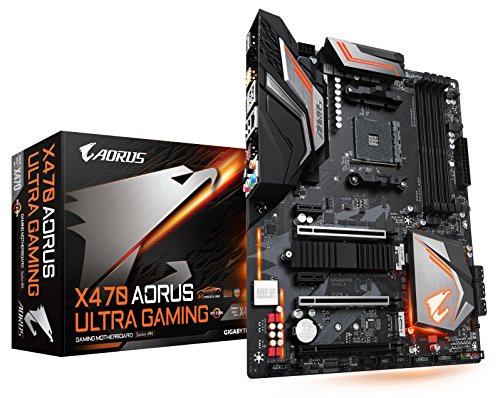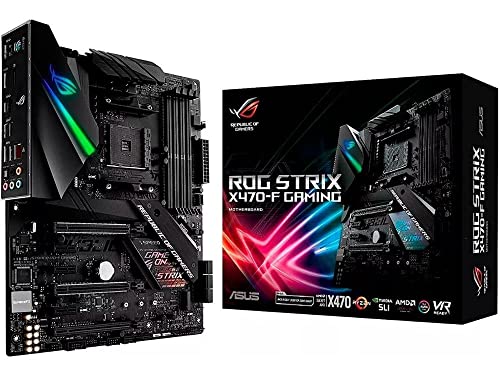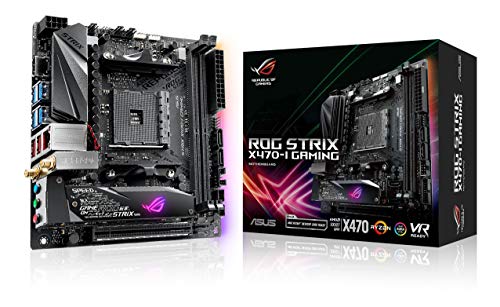Table of Contents
X470 motherboards were mostly targeted towards enthusiasts who wanted to engage in some decent overclocking and/or multi-GPU setups for the previous generation of high-end Ryzen CPUs. However, with the release of 3000 Ryzen CPUs in addition to the previous generations of Ryzen CPUs, there are a select few best x470 motherboard that should be considered. But, with so many options out there, finding the best value X470 motherboard becomes a chore.
Related Article: X570 Motherboards: Budget, Mid-Range, and High-End
Best Value X470 Motherboards:
-
ASUS Prime X470 Pro

It supports 2nd and 3rd Ryzen generations, but keep in mind you’ll need a BIOS update for a 3rd gen CPU. You also get four DIMM slots that let you use up to 3600Mhz (OC) memory, with a maximum capacity of 64GB. The SafeSlot GPU slot makes sure that there’s no bending from large and heavy graphics cards, which does help with durability. You have an M.2 slot, and it has a heatsink on top to control temperatures. It’s also great that each of the onboard headers has support for both PWM and DC fans.
The design, as we mentioned, is great, and is only accented by the use of ASUS Aura RGB lights. You can use software to add a bit of flashiness to your build and choose how subtle you want it. It’s overall an excellent motherboard.

|
-
MSI X470 Gaming Plus

To begin with, you’ve got support for both 2nd and 3rd gen processors, and you can populate the four DIMM slots with up to 3466MHz (OC) of DDR4 memory. The Gaming Plus also has Steel Armor PCI-E slots that protect your motherboard from heavier graphics cards, and there’s no bending that could damage the GPU either. There is also support for AMD’s CrossFire, which lets you use two (or three) GPUs alongside each other. With multi GPU setups being a dying breed, it’s nice to see MSI still gives you the choice.
You also have MSI’s Click BIOS 5, which is great and extremely user-friendly, as well as Mystic Light and Mystic Light Sync with 7 colors. Add to this the EZ Debug LED, which is by far the easiest method of troubleshooting, and you’re getting a very versatile board that’s great for just about anyone.

|
-
MSI X470 Gaming PRO Carbon

There are four DIMM slots on the motherboard, for a total of up to 64GB of DDR4 memory, at a maximum of 3466MHz. You also have DDR4 Boost which helps keep memory stable when overclocked Where it improves on something like MSI’s own Gaming Plus is GPU support – you can not only have two- or three-way CrossFire, but you also have support for Nvidia SLI.
As far as connectivity goes, you have Intel LAN for stable gaming, but no Wi-Ri. The audio section is pretty good with a Realtek ALC1220 Codec. You also get a USB 3.1 Gen 2 Type C port at the rear, which is slowly becoming the industry standard.
All things considered, the X470 Gaming PRO Carbon is an excellent value motherboard, especially for users who don’t want to spend a load of money on their motherboard but would still want to get all the good features of high-end models.

|
-
Gigabyte X470 AORUS Ultra

To begin with, you have four DIMM slots that can have up to 64GB of memory. While most of the competition caps out at 3200MHz or 3466MHz, Gigabyte lets you go for 3600MHz (OC) memory, so you get a bit more out of your system. There’s plenty of slots on the motherboard, from the two PCIe 3.0 that let you use two-way SLI or CrossFire, to the two M.2 slots for plenty of storage.
The audio section is another highlight of the AORUS Ultra, with ALC1220-VB codec and WIMA Audio Capacitors making sure you get great sound without needing to get a sound card. There’s also RGB lights with RGB fusion, but they’re discreet and won’t make your build too flashy. Overall, an excellent value X470 motherboard with plenty of features.

|
-
ASUS ROG Strix X470-F

First things first, the four RAM slots can run up to 64GB of memory at up to 3600MHz, which is great. With multiple PCIe slots, you can have Nvidia 2-way SLI or AMD 3-way CrossFireX for a multi GPU setup. The M.2 heatsink keeps the M.2 drive cold, and you have Asus’s 5-Way Optimization that automatically tailors overclocking and cooling profiles for your rig.
Even though there’s no Wi-Fi, you have Intel gigabit ethernet with LANGuard, so quick file transfers shouldn’t be an issue. The audio section of the Strix X470-F is excellent, with SupremeFX S1220A and Sonic Studio III giving you great sound without the need for an additional sound card. If you don’t mind paying a bit more for an X470 motherboard, the ROG Strix X470-F should definitely make it to your shortlist.

|
High-End X470 Motherboards:
-
ASUS ROG Crosshair VII Hero (Wi-Fi)

First things first, you have four DIMM slots, each of which can fit up to 16GB of DDR4 memory at 3600MHz (OC). The 5-Way Optimization comes with Auto-Tuning and FanXpert 4, so you get automatic profiles for overclocking. Pair this with fast ram that has XMP support, and you’ll get a really fast system.
You get two M.2 slots for plenty of storage, and you also have 2×2 Wi-Fi with MU-MIMO 802.11ac networking. Add to this the SupremeFX S1220 audio with Japanese capacitors, and you’ll see where your money is going.
Oh, and lest we forget, while the black and red ROG theme is instantly recognizable, you have Aura Sync RGB headers that let you add additional lighting to showcase your build. The Crosshair VII Hero (Wi-Fi) is definitely a motherboard that you should consider when looking for a high-end X470 solution.

|
-
Gigabyte X470 AORUS Gaming 7 Wi-Fi

Let’s discuss memory first, as this is where you get a lot from the AORUS Gaming 7. You have four DIMM slots for up to 64GB of memory. However, you can have up to 4133MHz (OC) memory modules, which is impressive. The audio section is also excellent, with a 7.1 channel Realtek ALC1220-VB codec. Networking shouldn’t be a concern, thanks to both the Intel gigabit ethernet chip, and the 802.11ac Wi-Fi module. You also have Bluetooth 5, which might come in handy for peripherals and file transfer.
The dual M.2 slots have thermal guards to keep them cool, and the VRM section is adequately cooled with a heatsink, too. And if you like RGB, there’s basically no better choice – you have it on the PCIe slots, on the RAM slots, below them, above the IO shield – everywhere. And it’s all controllable with RGB Fusion 2.0, and you can add more via the headers.

|
-
ASRock X470 Taichi Ultimate

First things first, this is one of the few boards that has support for both Nvidia Quad SLI, and AMD Quad CrossFireX. Other boards can have at most three GPUs, but you can have four here, from both the red and green camp, as you wish. Memory support tops out at 3466MHz (OC), though, which is less than some other options we’ve seen. You have 7.1 channel audio with a Realtek ALC1220 codec, as well as AQUANTIA 10 gigabit LAN and Intel’s 802.11ac Wi-Fi module.
We also have to give a nod to ASRock’s design team, which have done a great job with the Taichi Ultimate. It’s a black and silver design, but still has an RGB LED with ASRock’s Polychrome RGB Sync, and you have additional headers for a bit more light. If you don’t need extremely fast memory, but want to run a multi GPU setup, this is a great option.

|
X470 Mini-ITX Motherboards:
-
ASUS ROG Strix X470-I

As you’d expect from a mini ITX board, you only have two DIMM slots, for a maximum of 32GB of DDR4 RAM. You can push it up to 3466MHz (OC), though, so you can fit some pretty fast memory. There’s also one PCIe 3.0 slot, but you do have two 2280 M.2 slots, one of which can also work in SATA mode.
The audio and networking sections of the Strix X470-I are both great. You have SupremeFX S1220 audio, which does give you great sound, and aside from LAN, you also have 2×2 Wi-Fi 802.11ac with MU-MIMO support.
The board is rounded out by Asus’s RGB lights with Aura Sync support, and you do get additional headers if you want to add even more light to your build. Overall, it’s definitely one of the best X470 mini ITX motherboards.

|
-
ASRock X470 Fatal1ty ITX/AC

The two DIMM slots let you have up to 32GB of dual-channel DDR4 memory, and you can run it at speeds of up to 3466MHz if you’ve got a 3rd generation AMD CPU. There is one PCIe slot, and one Ultra M.2 socket (2280), which supports NVMe SSDs as a boot drive.
While there’s no RGB on the board, it does have addressable LED headers so you can add extra lighting if you want to. It’s also worth mentioning that it makes use of high-quality Nichicon capacitors and a Dual-N MOSFET, as well as high-density glass fabric PCB, so no corners were cut in the build quality of the board itself.
It may not be the most beautiful, or the flashiest mini ITX board out there, but if you want quality and aren’t too concerned with looks, the X470 Fatal1ty ITX/AC is a great choice.

|

